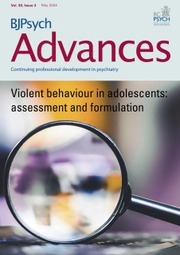No CrossRef data available.
Article contents
Understanding violence in the context of psychosis: contribution of phenomenology and its limitations
Published online by Cambridge University Press: 25 September 2024
Summary
Navigating the complex relationship between violence and psychosis can frequently be challenging. Psychiatrists may find assessing and managing the risk of violence in this context daunting. In their article on the topic, Anderson et al helpfully summarise the role that psychopathology can play in this process. However, although careful elucidation of an individual's experiences may assist in the nuanced formulation of their risk and could offer a specific focus for interventions, the approach has potential shortcomings in certain settings. For some phenomena the link with violence is unclear and it may be constellations of symptoms that are important. Causal pathways are not always linear and there may be important mediators linking psychopathological features to behavioural outcomes. In the resource-limited settings in which many contemporary health services operate, a detailed assessment of psychopathology may be hampered by time or other constraints. Alternative, more scalable solutions may therefore be needed in particular scenarios.
- Type
- Commentary
- Information
- Copyright
- Copyright © The Author(s), 2024. Published by Cambridge University Press on behalf of Royal College of Psychiatrists
Footnotes
Commentary on… The clinical assessment of violence in the context of psychosis. See this issue.




eLetters
No eLetters have been published for this article.